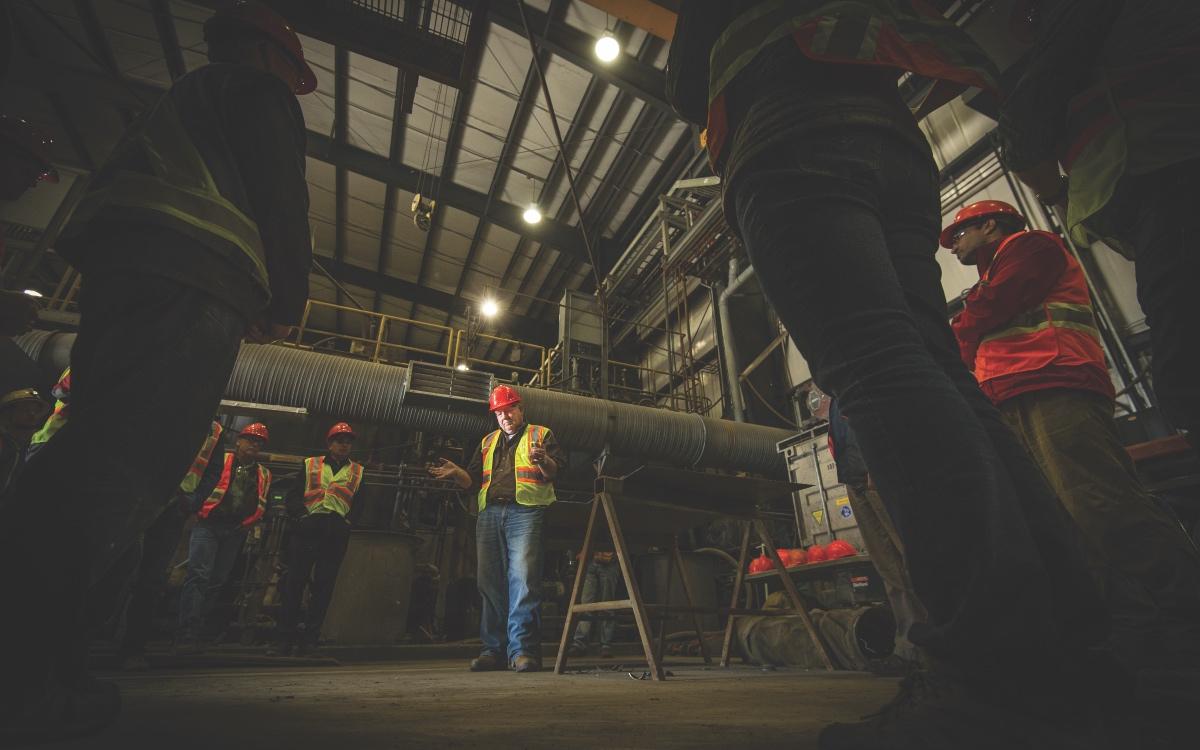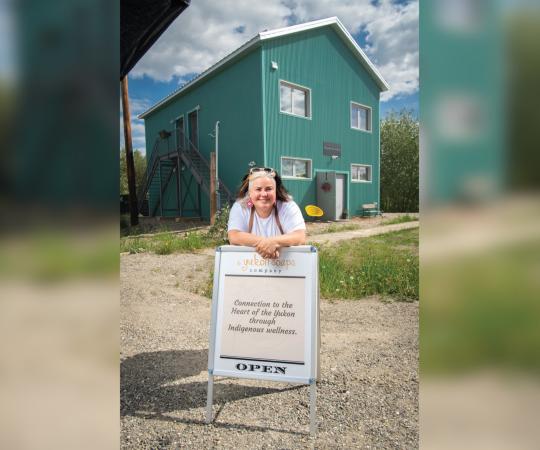It’s late September and snow is falling on Alexco Resource Corp.’s sprawling Flat Creek mining camp. Company president Brad Thrall can see the tumbling flakes from his office window, which is set in the mountainous wilds of the central Yukon, 340 kilometres north of Whitehorse. “Winter comes early up here, but this is still early for us,” he says with a grimace. His chagrin at the sudden onset of winter, however, is more than made up for by his enthusiasm for other developments taking place outside his office. Work is ramping up at two of the company’s mine sites—Bermingham and Flame & Moth—deposits that Thrall believes contain some of the world’s highest-grade silver deposits.
Silver is a rare commodity and is usually found as a byproduct of the mining of other metals, such as gold, zinc, or lead. In fact, only 28 per cent of silver comes from mining activities where it is the primary source of revenue. Primary silver mines are uncommon, especially ones with high grades. “We’re a rare breed in the silver space,” says Thrall, who notes that the average grade of the new deposits that Alexco has discovered check in at 800 grams of silver per tonne. “From 75 to 80 per cent of our revenue from these mines will come from silver… And we have over 100 million ounces of silver in the ground, with only 30 per cent of that in the current mine plan.”
The opening of Bermingham and Flame & Moth mark a return to production for Alexco. The company opened a silver mine on the site at the start of 2011. The Bellekeno mine, which was put into production in an incredibly fast three years from exploration to operation, including all licences and permits, won Thrall and Alexco O Clynt Nauman the 2011 E. A. Scholz Award for excellence in mine development. The project produced about two million ounces of silver and more than 20 million pounds of lead and zinc concentrate per year until September 2013, when mining was halted due to collapsing silver and base metal prices.
Thrall says that the newly discovered deposits promise a much higher return. Early in 2019, Alexco completed a study that forecasts a 430-metric-ton-per-day operation producing 27.2 million ounces of silver, 67 million pounds of zinc and 65.4 million pounds of lead over an eight-year mine life. These numbers represent a major windfall for Alexco, a Vancouver-based junior exploration and reclamation company that acquired a huge haul of 800-plus mineral claims in a landmark partnership with Canada’s federal government in 2006.
The deal saw Alexco become owner of the Yukon Keno Hill Silver District, a 230-square-kilometre property that was Canada’s second largest primary silver producer and one of the richest silver-lead-zinc deposits ever mined, producing 214 million ounces of silver between 1913 and 1990. A mainstay of the Yukon economy for 40 years, the mines here at the end of the Silver Trail highway supported about 15 per cent of the territory’s population at their peak in the 1950s and early 1960s. They also produced more wealth than the Klondike, one of the richest placer gold districts the world has ever seen.
But Alexco’s acquisition of this property came with a stipulation—the company had to stop ongoing environmental degradation in the area and clean up the mess left by previous mining operations. These defunct mines, scattered across the region and numbering more than 30 in total—with names like Keno, Onek, Lucky Queen, Elsa, and Silver King—were consolidated under one company, United Keno Hill, in the 1950s. The cleanup of their legacy poses a daunting challenge. “Everything from the very first mining in 1913, that is Silver King, is part of this plan,” Thrall says. “So, you are going back 100 years.”
Ottawa initially insisted that any company that bought the silver assets would have to accept responsibility for all existing liabilities—tailings, exposed waste rock, open shafts and adits, and the other detritus associated with a century of mining—but the government eventually modified its position and agreed to award Alexco the assets while keeping Canadian taxpayers on the hook for the majority of the abandoned liabilities.
For its part, Alexco promised to help develop and execute a reclamation plan to complete the clean-up, which has been estimated to cost between $70 million and $100 million. The reclamation initiative is the only case in Canadian history where the responsibility to develop a remediation plan was done through a private-public partnership.
The scenario that enabled this partnership to materialize arose because United Keno Hill Mines Ltd., which had successfully operated here for nearly five decades, declared bankruptcy in 1989 and abandoned the district. Most of the miners and their families who lived in the nearby towns of Keno City or Elsa departed, leaving behind houses, furniture, and old mining equipment. Only a few hardy folk remained, most of whom now live in Keno City and maintain the town’s services and museum. Elsa became a ghost town.
The shut-down also left serious environmental impacts behind, most notably the zinc-laden water seeping out of several entrances and underground tunnels, and from a tailings pond, which is harmful to fish and destructive to aquatic habitats. There is also an estimated 4.5-million tonnes of tailings which were simply dumped into a valley just outside of the town of Elsa.
In 2001, Indigenous and Northern Affairs Canada asssumed official control of the site. The federal government has been babysitting these damaged assets ever since at a cost of approximately $2 million per year for ongoing water treatment and other measures. In 2005, the government sent out 38 requests for offers to purchase. Nine were received in response. Alexco’s bid won approval.
Alexco was granted access for mineral exploration and to undertake the day-to-day care and maintenance of the site. Under the terms of the agreement, a unit of Alexco known as the Elsa Reclamation and Development Company Ltd. (ERDC), would own the former assets of United Keno Hill Mines and be responsible for the care and maintenance of the properties as well as the eventual reclamation and closure of the sites. Alexco Keno Hill Mining Corp., a separate subsidiary of Alexco Resource Corporation, would be responsible for mineral extraction.
The purchase price for the assets was $410,000. Alexco also agreed to spend $10 million to help fund the clean up and agreed to build a modern water treatment plant. “That money was put in a trust where it has been accruing interest,” Nauman says. “It’s over $12 million now.” The money has not been touched because reclamation has only just begun as the time since the purchase has been consumed by planning, permitting, and haggling over costs and responsibilities. (The agreement was revised in 2012 to redistribute how costs are shared and also to allow ERDC to recoup any balance of its alloted $10 million if the final closure work comes in under budget.)
Thrall says that the clean-up plan calls for the company “to capture three of the biggest sources of the zinc-contaminated water, put it into a pipeline and bring it to the new water-treatment plant, which will treat the water in perpetuity. “We will also collect all the tailings, compact them in a single location and put a cover over them. We’ll change the water management and add lime to them to make sure they are stable.” Thrall estimates it will take about five years to complete the work.
Alexco has also forged an Impact and Benefits Agreement with the First Nation of Na-cho Nyak Dun, whose ancestral lands occupy the area on which the silver deposits are found. The agreement, negotiated in 2007, covers the care and maintenance as well as exploration activities undertaken by ERDC. A second mining IBA would be concluded if ERDC determined that any part of the property should be developed into a mine operation.
To understand how Alexco became the choice to breathe new life into zombie mines at Keno Hill, one must travel back in time to the 1990s when Thrall and Nauman, who is Alexco’s chair as well as CEO, were managing a company called Viceroy Resources Corp. Both were experienced hands in the mineral exploration business. A geologist by trade, Nauman had more than 30 years in the industry, ranging from exploration and business development to operations and business management in the precious metals, base metals and coal sectors. Thrall, meanwhile, had spent more than two decades in operations management, environmental management, and mine-closure planning and execution.
Viceroy operated an open-pit gold mining venture about 57 kilometres due east of Dawson City called Brewery Creek. That project, which ran from 1997 to 2001, used a heap-leach method to extract some 300,000 ounces of gold, before tumbling gold prices caused it to suspend production.
While running that mine, Thrall and Nauman formed a consulting outfit called ALM, which specialized in mine reclamation and closure. They worked on two projects, Brewery Creek and another mine in California. They were rewarded for their efforts by winning the Department of Indian Affairs and Northern Development Robert E. Leckie Award for outstanding reclamation work in 1999 and 2002, an honour conferred on companies or individuals who go beyond legislated reclamation requirements, pioneer new reclamation techniques in the North, and show leadership in enhancing the environment.
Contacted by phone at a company office in Blaine, Wash., Nauman explains that he and Thrall formed ALM because they thought the remediation aspect of mining was often neglected in the industry. “We recognized that not enough attention was being paid to the long-lived liabilities that are part of a mining operation. We felt there was a better way that the liabilities could be offset as much as possible and have a mine positioned to be properly reclaimed, and the land returned to its highest and best use,” he says.
The timing was perfect for a for-profit reclamation business because many mining concerns had been forced into bankruptcy by collapsing metal prices in the 1990s, leaving behind both environmental damage and unexploited resources.
The pair ran ALM for three years before founding Alexco in 2005. From the start the company pursued a unique business model. As Thrall notes, “We look for somewhat distressed, environmentally impaired assets within the resource sector that still have resource upside. By employing our skill set on the reclamation and remediation side, we’re able to solve the environmental challenges at some of these properties and at the same time look to see if we can unlock the resource potential.”
Thrall says that the brand recognition that he and Nauman earned from the Brewery Creek cleanup and some others they were involved with caused the federal government to contact them when it launched the sales process for the Keno Hill property. He believes Alexco won the bid because it had expertise on two fronts—reclamation work and the ability to build mines, a combination that the rival bidders lacked.
Nauman and Thrall were intrigued by the resource potential of the Keno Hill district because they were familiar with Yukon geology and because they knew that the mine’s previous owners had not ceased operations because they had exhausted the supply of silver. Instead, they were deep-sixed by falling precious metals prices and an inability to afford the costs of enhanced environmental regulations. Nauman and Thrall reasoned there was still silver in those hills waiting to be discovered.
Upon winning the bid, Alexco acquired Access Consulting Group, a Whitehorse-based environmental firm that had great expertise on permitting issues in the Yukon. The 2006 purchase—for $2 million, of which $1 million was paid in cash, with the remainder paid out in Alexco shares—enabled Alexco to strengthen its expertise in the environmental, permitting, regulatory and reclamation disciplines while adding highly qualified and successful industry leaders to its senior management team.
After completing that transaction, Alexco formed its own consulting firm, Alexco Environmental Group (AEG). It proved to be a shrewd move. With former Access execs in harness, the subsidiary would enjoy greater success than Nauman and Thrall had envisioned. “AEG eventually became larger than Alexco, with about 100 employees and five or six offices across the U.S. and Canada, and a number of high-profile clients,” Nauman says.
Alexco operated AEG until February 2020 when it sold the company to AEG’s management group for $13.35 million. Despite the sale, Alexco retained the benefits of the ERDC work at Keno Hill. In a press release, Nauman called the sale “an important strategic step toward streamlining our business and allowing us to focus wholly on our mining and exploration endeavors.”
The exploration work that Alexco conducted after suspending activity at Bellekeno eventually paid off with the Bermingham and Flame & Moth discoveries. Both were detected by astute geologic research. Nauman says that the Bermingham discovery, in particular, was due to the dogged efforts of geologist Seymour Iles, who saw patterns in the rock there that resembled those in Bellekeno.
Iles’s intuition proved correct. In 2017, Alexco pegged the silver resources at Bermingham at 17.3 million ounces. It pushed the deposit up to second place in terms of size, second only to the 26.7 million estimated for the Flame & Moth deposit. But Bermingham displays a substantially higher grade, meaning less rock has to be removed to retrieve the equivalent amount of silver.
As winter closes in on the Yukon, Alexco has been removing the remaining ore from Bellekeno and using it to prep the mill for the next stage of production—the extracting of ore from Bermingham and Flame & Moth. The company has made some modifications to the mill and wants to make sure it is all running smoothly. When the mine reaches full production in 2022, Alexco will employ 200 people.
Thrall says that the rising price of silver and the weak Canadian dollar have made developing a silver mine here a far more enticing enterprise than in 2013, when Bellekeno closed. Back then, the Canadian dollar was worth more than the American dollar, not an ideal scenario for a company whose expenses are largely in Canadian money and whose sales are in American dollars. But with the Canadian dollar now around 78 cents, the scales are in Alexco’s favour.
As the machinery grinds on at Bermingham and Flame & Moth, Alexco continues to seek new deposits. To date, only 12 per cent of the district has been explored, leaving ample opportunity for the company to continue growing its resources. In fact, Nauman says that a 2020 drilling exploration program included a discovery of a significant zone of high grade silver mineralization beneath the current Bermingham deposit. He says there are indications that the richness of the ore here may rival the famous Hector Calumet deposit, which produced 96 million ounces of silver prior to shutting down in 1972.
Whether that prediction holds remains to be seen, but as Nauman admits, with geologists the next big thing is always waiting ahead just over the horizon. “We’re blue-sky guys. Dreamers,” he says, chuckling.










